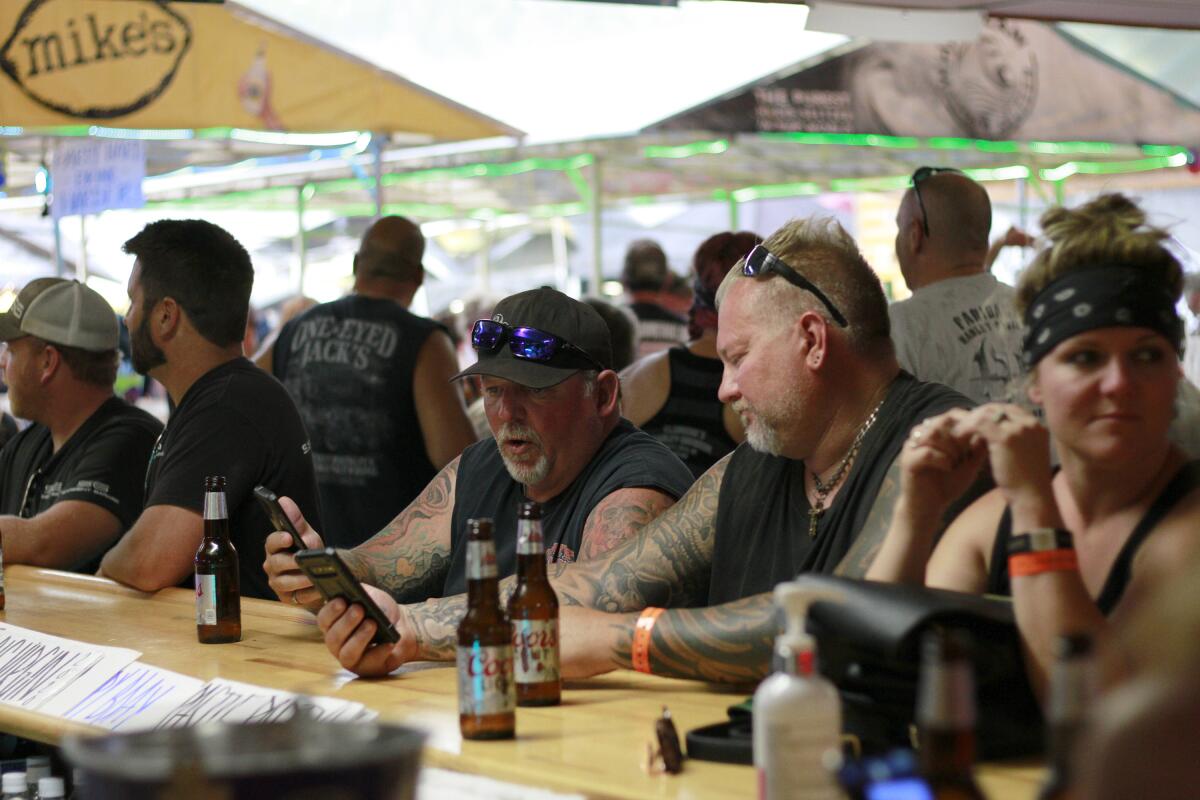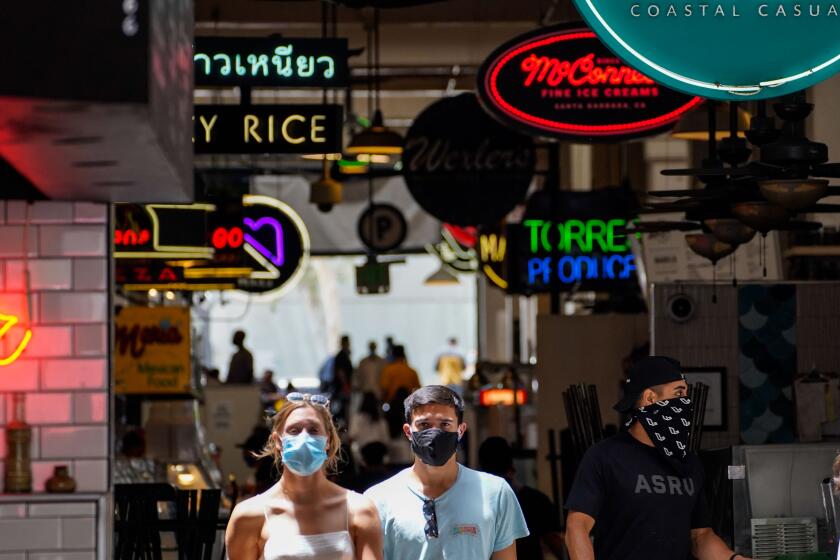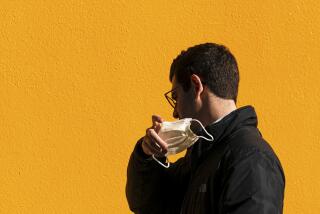Dakotas lead U.S. in growth of coronavirus cases as both states reject mask rules

- Share via
Coronavirus infections in the Dakotas are growing faster than anywhere else in the nation, fueling impassioned debates over masks and personal freedom after months in which the two states avoided the worst of the pandemic.
The argument over masks raged this week in Brookings, S.D., where the City Council considered requiring face coverings in businesses. The council was forced to move its meeting to a local arena to accommodate intense interest, with many citizens speaking against it, before the mask requirement ultimately passed.
The Republican governors of both North Dakota and South Dakota have eschewed mask requirements, tapping into a spirit of independence.
Infections have been spurred recently by the reopening of schools and universities and by mass gatherings such as the Sturgis Motorcycle Rally, which drew hundreds of thousands of people from across the country to the small South Dakota town.
“It is not a surprise that South Dakota has one of the highest [COVID-19] reproduction rates in the country,” Brookings City Councilman Nick Wendell said as he commented on the many people who forgo masks in public.
Requirements that customers wear masks in stores, restaurants and other establishments are often just requests. Workers must enforce compliance.
Amid the brute force of the pandemic, health experts warn that the rise in infections must be contained before healthcare systems are overwhelmed. North Dakota and South Dakota rank first and second, respectively, in the U.S. in new cases per capita over the last two weeks, according to Johns Hopkins University researchers.
The states have also posted some of the country’s highest positivity rates for coronavirus tests in the last week — with nearly 22% of tests coming back positive in North Dakota — an indication that there are more infections than tests are catching.
After early, serious outbreaks at meat processing plants, the Dakotas appeared to have avoided the worst of the pandemic, watching from afar as it raged through large cities. But surging infection rates have fanned out across the nation, from the East Coast to the Sun Belt and now into the Midwest, where states such as Iowa and Kansas are also dealing with growing outbreaks.
When the case count stayed low during the spring and early summer, people grew weary of constantly taking precautions, said Dr. Benjamin Aaker, president of the South Dakota State Medical Assn.
“People have a tendency to become complacent,” he said. “Then they start to relax the things that they were doing properly, and that’s when the increase in cases starts to go up.”
Health officials point out that the recent coronavirus case increases have been among younger groups that are not hospitalized at high rates. But infections have not been contained to college campuses.
“College students work in places where the vulnerable live, such as nursing homes,” said Dr. Joel Walz, the Grand Forks, N.D., city and county health officer. “Some of them are nursing students who are doing rotations where they’re going to see people who are really at risk. I worry about that.”
Over 1,000 students at the states’ four largest universities — University of North Dakota, North Dakota State University, South Dakota State University and University of South Dakota — have had to leave campus to quarantine after being exposed to the virus, according to data released by the schools. The Sturgis rally also spread infections across the region, with health officials in 12 states reporting over 300 cases among people who attended the event.
But requiring masks has been controversial. In Brookings, opponents said they believed that the virus threat was not as serious as portrayed and that a mandate was a violation of civil liberties.
“There are a lot of things we have in life that we have to deal with that cause death,” business owner Teresa Haldeman told the council. “We live in America, and we have certain inalienable rights.”
Though Brookings passed its ban, another hot spot — North Dakota’s Morton County, just west of the capital city of Bismarck — soundly rejected a mask requirement after citizens spoke against it. Brookings may be the lone municipality with such an order in the Dakotas outside Native American reservations, which have generally been more vigilant in adopting coronavirus precautions. Native Americans have disproportionately died of COVID-19, accounting for 24% of the combined deaths in the two states.
North Dakota Gov. Doug Burgum and South Dakota Gov. Kristi Noem have resisted mask requirements. Burgum promotes personal choice but encouraged masks with a social media campaign. Noem has discouraged mask requirements, rejecting the broad consensus of the medical community that they help prevent infections.
At a news briefing, Burgum projected a chart that showed active cases in neighboring Minnesota rising to record levels since it implemented a mask mandate July 25.
“In the end, it’s about individual decisions, not what the government does,” he said.
Noem, who has yet to appear at a public event with a mask, carved out a reputation as a staunch conservative when she defied calls early in the pandemic for lockdown orders.
But both governors face increasing pressure to step up their approach. North Dakota’s average rate of test positivity has been nearly 22% over the last seven days, according to the the COVID Tracking Project; South Dakota’s has been 17%.
Dr. Anthony Fauci, infectious-disease chief at the National Institutes of Health, told MSNBC that he found those figures “disturbing,” especially as fall weather arrives and Americans begin spending more time indoors.
“You don’t want to start off already with a baseline that’s so high,” Fauci said.
Neither governor appears ready to yield any ground.
“We will not be changing that approach,” Noem spokesman Ian Fury said Thursday, citing a low hospitalization rate and the fact that only 3% of intensive care beds are occupied by COVID-19 patients.
Doctors in both states warn that their healthcare systems remain vulnerable. Small hospitals in rural areas depend on just a handful of large hospitals to handle large inflows of patients or complex procedures, said Dr. Misty Anderson, president of the North Dakota Medical Assn.
Aaker, the president of the South Dakota physicians group, said medical practices have seen patients delaying routine care during the pandemic, meaning that doctors could soon see an uptick in patients needing more serious attention.
“Now we are adding a surge in coronavirus cases potentially,” he said. “They are worried about being overwhelmed.”
More to Read
Sign up for Essential California
The most important California stories and recommendations in your inbox every morning.
You may occasionally receive promotional content from the Los Angeles Times.











